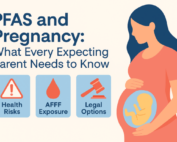Introduction
PFAS (“forever chemicals”) litigation has exploded into one of the largest mass-tort and environmental battles in U.S. history. While there have already been landmark settlements for public water systems, individual injury cases are only now moving toward bellwether trials— and defendants are deploying sophisticated legal and financial tactics to cap, delay, or shift their liabilities.
Here’s a clear, up-to-date explainer on where the AFFF/PFAS multidistrict litigation (MDL 2873) stands, what’s coming next, and the playbook companies are using to minimize exposure.
Where the AFFF Lawsuit Stands Now (As of Sep 2025)
Personal injury trials are (finally) on the runway
Originally, the court signaled an effort to streamline—potentially trying a single kidney-cancer case first on October 20,2025—and issued a short “filing facilitation window” as filings surged.
The court’s Case Management Order (CMO) 35 vacated the previously targeted October 2025 kidney‑cancer bellwether trial and created a Filing Facilitation Window for personal‑injury claims involving the six listed injuries:
CMO 36 clarifies pleading requirements—particularly around properly alleging AFFF-related exposure.
Water-system settlements finalized and paying out
Public water suppliers obtained historic class settlements: 3M’s ~$10.3–$12.5B agreement (payments over 13 years) received final approval and is in the payout phase, and DuPont/Chemours/Corteva’s $1.185B settlement for water systems was approved in early 2024.
State AG actions continue in parallel
States have secured their own environmental settlements (for example, New Jersey’s 2025 agreement—hundreds of millions over decades—with Chemours/DuPont/Corteva), separate from the MDL’s personal‑injury track.
Regulatory backdrop is in flux but trending stricter
EPA has moved to designate PFOA/PFOS as CERCLA hazardous substances and set national drinking‑water standards for certain PFAS; ongoing petitions and challenges may adjust implementation timelines, but the overall direction strengthens contamination findings and cleanup obligations.
Tactics defendants are Using to minimize PFAS liability
Companies facing PFAS lawsuits have developed a playbook of strategies to cut down what they might owe. These methods can sound technical, but the basic idea is simple: they try to settle where it looks cheapest, push responsibility onto other entities, and argue over the science to slow things down.
Here’s how those moves break down, along with easy-to-understand explanations.
1) Segmented Settlements: Fund Infrastructure, Fight Injuries
By settling with public water systems first, defendants remove the most visible public‑health pressure while maintaining a harder line on personal injury claims that require individualized proof of exposure, dose, and causation.
How this tactic works: Imagine a company paying to fix the town’s pipes but refusing to help the sick people in the town until each person proves exactly how the water made them sick. It looks like progress, but leaves injured people waiting.
2) Corporate Restructuring & Liability Off‑Loading
Legacy PFAS liabilities have been shifted into spinoffs and indemnity chains (e.g., the DuPont → Chemours split). These structures can push environmental and tort liabilities onto smaller balance sheets, altering settlement leverage.
How this tactic works: Think of a parent giving all the family’s debt to one child who has the smallest paycheck. That way, if the family gets sued, there isn’t much money left to collect.
3) Bankruptcy “Shadowboxing”
Even when not executed, Texas Two‑Step–style strategies loom over negotiations. In other mass torts (asbestos, talc), liability subsidiaries filed for Chapter 11, pausing litigation and forcing global deals at reduced valuations. The mere threat of such moves can pressure earlier, lower settlements.
How this tactic works: It’s like saying, “If you push me too hard, I’ll just shut down my shop and you won’t get paid.” Even if they don’t actually close the shop, the threat makes people settle for less.
4) Insurance, Indemnity & Back‑End Cost Recovery
Manufacturers pursue insurer reimbursements and cross‑indemnities to reduce net cash outflows. This doesn’t compensate injured plaintiffs but strengthens defense settlement posture.
How this tactic works: Picture someone breaking your window, then telling their insurance to cover it. They aren’t really paying—they’re just moving the bill to someone else.
5) Regulatory Lobbying and Policy Narrowing
Industry groups lobby to slow, narrow, or phase in PFAS rules (definitions, CERCLA application, Safe Drinking Water Act implementation). Any pause or carve‑out is used to argue uncertainty and depress damages in negotiation.
How this tactic works: If the rules about cleaning your room keep changing, you can argue you don’t have to clean it yet. Companies use these delays to avoid paying until the rules are final.
6) Procedural Maneuvers: Causation & Expert Challenges
Expect Daubert motions, dose‑specific attacks, and PFAS‑species parsing (PFOA vs PFOS vs PFHxS, etc.). With the bellwether schedule vacated, defendants have more time to litigate admissibility and atomize exposure pathways.
How this tactic works: They argue over the tiniest details, like whether the smoke from one campfire versus another caused your cough. By splitting hairs, they delay decisions and make lawsuits harder to win.
7) State Settlements, Releases, and “Remediation Narratives”
State‑level environmental settlements cap portions of exposure and allow defendants to argue that remediation is underway, constraining the scope of additional damages sought by private plaintiffs.
How this tactic works: If a company pays the state to clean a river, they then say, “See, we fixed it!”—and use that to claim they shouldn’t have to pay sick residents anymore.
What does this mean for Individuals injured by PFAS?
The trial clock is paused, not dead
The court is prioritizing getting cases filed and vetted over rushing into a first trial. That means no confirmed bellwether dates right now.
File properly—and fast
CMO 35 (filed August 15, 2025) created a “Filing Facilitation Window” giving plaintiffs a short period (21 days) to file all personal injury cases involving the six core PFAS-related conditions. Conditions include kidney cancer, testicular cancer, thyroid disease, liver cancer, ulcerative colitis, and thyroid cancer.
Initially, that window was set to run through September 5, 2025. The court later extended the deadline to September 10, 2025 for unfiled cases.
Cases filed by or before the deadline get certain procedural advantages: they avoid more stringent requirements for expert disclosures, stricter timeline pressures, and extra documentation burdens that the court has imposed on late-filed cases.
After the September 10, 2025 filing window closes, any new personal injury case for those six conditions can still file a claim, but will be subject to stricter procedural burdens (e.g. stricter causation proof, stricter timelines for medical records, etc.) which also costs more towards proving your claim.
Kidney cancer still leads on the science
While timelines changed, kidney cancer remains the injury category with the strongest epidemiology tying exposure (especially to PFOA) to risk, closely followed by testicular cancer and ulcerative colitis—making proper filing and case development especially urgent for those claimants.
Important Things you need to know
Do not confuse water‑system payouts with personal injury recovery
There’s a lot of media coverage on municipal water settlements for PFAS contamination. Municipal settlements do not pay individuals for cancer or other illnesses.
If you have a diagnosis linked to PFAS, you still need to file your own claim as these do not fall under the municipal settlements.
Document exposure the right way
Combine residence/work history (military bases, airports, industrial sites), AFFF use or proximity, and water testing with medical records and (ideally) a medical nexus opinion.
Expect hard‑fought expert battles
With no immediate trial date, defendants will double down on causation and biomarker challenges. Choose firms and experts backed with deep PFAS experience.
FAQs About Impacts to PFAS Injury Lawsuits
Bottom Line
Companies aren’t escaping PFAS liability—they’re managing it.
With CMO 35 and 36, the court has paused bellwether timing to force cleaner filings and exposure pleadings. Defendants will use the extra time to press procedural advantages, refine regulatory arguments, and pursue insurance offsets.
For injured individuals, the imperative is clear: file correctly within the court’s window, document exposure rigorously, and prepare for expert‑heavy litigation.
The outcomes of the first properly teed‑up trials—when they’re eventually set—will likely reset the valuation of PFAS injury claims across the board.
Written By:

Andrew J. Cobos
Lawyer and Legal Reviewer
Andrew J. Cobos serves as the Chief Veteran Legal Counsel at PFAS Water Experts. As a veteran lawyer, he represents military veterans impacted by AFFF water contamination on military bases in ongoing PFAS mass tort litigation. As a U.S. Military Academy graduate (2003) and combat veteran, he has a deep passion for helping those who have served our country get the compensation they deserve for complex injury cases.






